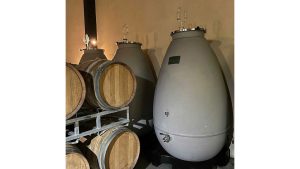Even though Frédéric Planchon works in an industry that is several thousand years old, he is far from just following the established processes of traditional winemaking. "We have developed a new system to age wine," says the managing director of Wine & Tools from Bordeaux. "We make barrels out of polyethylene with a special shape and design that puts the wine in contact with the right amount of oxygen to let it mature," explains Planchon. "This makes the wines smoother, rounder and fruitier."
Wine & Tools, headquartered in Bordeaux, produces such special plastic barrels in the French wine region of Aquitaine. They are used for wines from the regions of Cahors, Bordeaux, Narbonne, Côtes du Rhone, among others, but also for those from Spain and even for white wines from Germany.
Special moulds are needed to produce these egg-shaped polyethylene barrels, which are either painstakingly made by hand or milled from large aluminium blocks. In the latter case, only about 10 per cent of the aluminium used is utilised. "Ultimately, both methods are very cost-intensive," says Planchon, who has been developing products related to wine production for more than 20 years.
The first contacts with VLM Robotics were made five years ago. After the first test 3D prints (egg cups), the idea arose to "also use 3D printing with the robot to advance our business", says Planchon (see related article). "In doing so, I was mainly thinking about reducing the cost of our barrel moulds and making manufacturing more flexible and enabling more designs quickly." In the meantime, this has resulted in actual moulds for barrel production, in addition to the smaller-scale exhibit at Formnext 2021. "The challenge afterwards was to enlarge the moulds from a diameter of around 20 centimetres to more than a metre and at the same time make them strong enough for rotational moulding without making them too heavy and using too much material," says Planchon.
For development partner VLM Robotics, this meant experimenting with different wall thicknesses and using reinforcements in the right places. The two companies now seem to have found the right combinations: "In the meantime, we have come so far with the development that we will be able to use the first production-ready 3D-printed moulds in production in late summer 2022," says Planchon happily.
www.formnext.com

 Deutsch (Germany)
Deutsch (Germany)  Polski (PL)
Polski (PL) 










